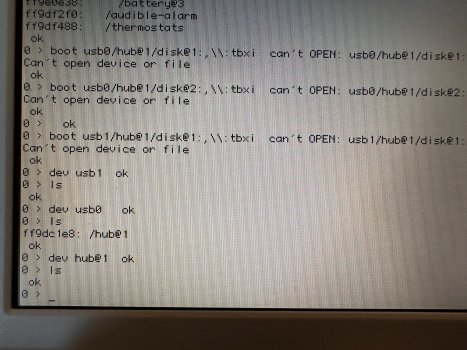I've come to realize that booting off a USB drive is not so easy for PowerPC. I've spent several hours trying to figure this out.
Essentially, ideally I would like to install a fresh copy of Tiger onto my SSD that is currently in a USB enclosure. The Tiger installer says it can't be installed since it cannot boot from the drive.
I then compromised and decided to just clone the drive instead of a fresh install. I used Carbon Copy Cloner to clone the current HDD to the SSD - telling it to backup everything. (This was after I formatted the drive with Apple Partition Map)
I then went into open firmware and tried to boot using these instructions.
With their guidance, I would do this:
1. dev / ls
2. identify where the USB disk is, in my case it is usb@1b/disk@1
3. I'd then type in /pci@f2000000/usb@1b/disk@1
And it would come back as "Unknown word" I'm stuck here.
I would eventually type in:
4. devalias ud /pci@f2000000/usb@1b/disk@1
5. dir ud:1,\
6. boot ud:1,\System\Library\CoreServices\BootX
Any thoughts on how I can get this iMac G4 1.25 GHz (20") w/ USB 2.0 to boot from a SSD in an enclosure?
I'm wondering if the clone isn't the way to go. So maybe a better question would be, how can I install Mac OS X Tiger on an SSD in an enclosure? (And then boot from it)?
Essentially, ideally I would like to install a fresh copy of Tiger onto my SSD that is currently in a USB enclosure. The Tiger installer says it can't be installed since it cannot boot from the drive.
I then compromised and decided to just clone the drive instead of a fresh install. I used Carbon Copy Cloner to clone the current HDD to the SSD - telling it to backup everything. (This was after I formatted the drive with Apple Partition Map)
I then went into open firmware and tried to boot using these instructions.
With their guidance, I would do this:
1. dev / ls
2. identify where the USB disk is, in my case it is usb@1b/disk@1
3. I'd then type in /pci@f2000000/usb@1b/disk@1
And it would come back as "Unknown word" I'm stuck here.
I would eventually type in:
4. devalias ud /pci@f2000000/usb@1b/disk@1
5. dir ud:1,\
6. boot ud:1,\System\Library\CoreServices\BootX
Any thoughts on how I can get this iMac G4 1.25 GHz (20") w/ USB 2.0 to boot from a SSD in an enclosure?
I'm wondering if the clone isn't the way to go. So maybe a better question would be, how can I install Mac OS X Tiger on an SSD in an enclosure? (And then boot from it)?







